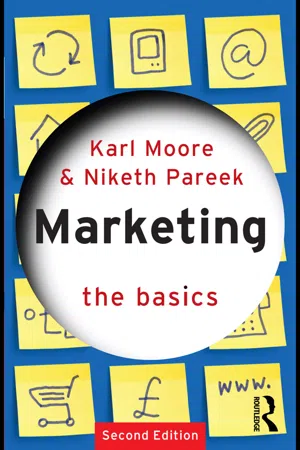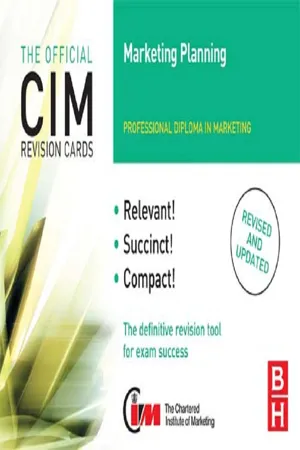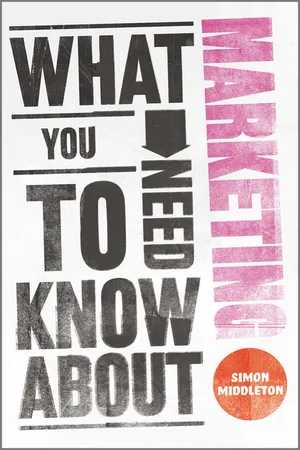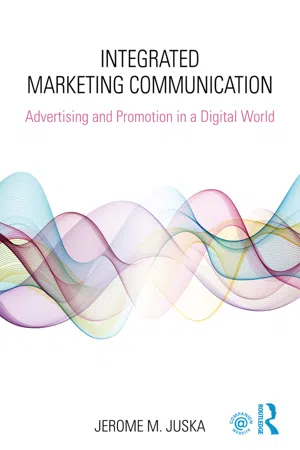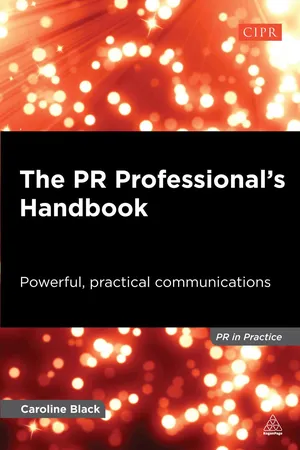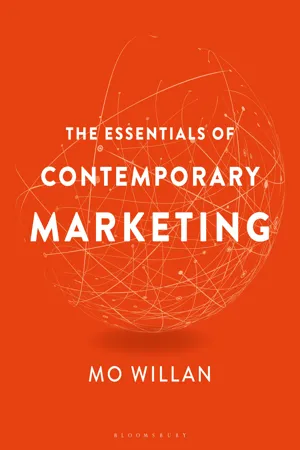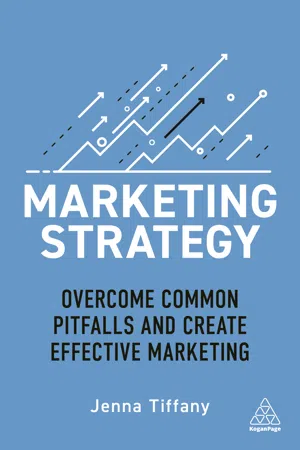Marketing
Promotion Marketing
Promotion marketing involves the use of various promotional tactics to increase the visibility and sales of a product or service. This can include advertising, sales promotions, public relations, and direct marketing. The goal is to create awareness, generate interest, and ultimately drive customer action.
Written by Perlego with AI-assistance
8 Key excerpts on "Promotion Marketing"
Learn about this page
Index pages curate the most relevant extracts from our library of academic textbooks. They’ve been created using an in-house natural language model (NLM), each adding context and meaning to key research topics.
- eBook - ePub
- Karl Moore, Niketh Pareek(Authors)
- 2009(Publication Date)
- Routledge(Publisher)
PROMOTIONPromotion is the fourth element of the marketing mix. Being successful in this element of the marketing mix not only builds good publicity for the firm but also ensures that the brand equity of the company’s products remains at a high level. Promotion involves disseminating information about a product or a company using six key types of promotions: advertising, sales promotion, public relations, personal selling, direct marketing and online marketing. Together, these elements form a company’s promotion mix . Each type of promotion employs a different set of approaches to communicate with the current and prospective customer. Since each type of promotional tool interacts with customers differently, the whole promotional mix must be integrated to deliver a consistent message regarding the strategic positioning of the company and the benefits of buying product regardless of the communication channel used.THE COMMUNICATION PROCESS
Regardless of the type of communication involved, there is a communicator, an audience, a channel and a message. The communicator is the person or company sending the message to the audience, who are either potential or current customers. The channel is the medium through which the message travels, and finally the message itself, which is the information the marketer wishes to transmit to the audience. Though this may seem like a simple process, even the best-designed messages face difficulties reaching the audience in the way the marketers intended. Your message has to compete against the thousands of other messages that are also trying to attract attention.If the message manages to diffuse through the clutter and reach the intended audience, it faces another hurdle: studies estimate the average American adult receives in excess of 3,000 messages everyday. This is not to say that the average American is simply sitting around watching television all day! When a bus goes by, it has multiple messages on the side. A co-worker walks into a meeting wearing a Nike sweater and with a cup of Starbucks coffee, two more examples of exposure to additional messages. It is impossible for a person to absorb and respond to that much information. Rather than being overwhelmed by stimuli, most consumers in have learned to ignore most messages. This creates a huge challenge for marketers. - eBook - ePub
- Gaynor Lea-Greenwood(Author)
- 2012(Publication Date)
- Wiley(Publisher)
A corporate strategy should guide all aspects of an organisation’s operations, into what are called functional strategies – product selection, price architecture, distribution and promotional activities. The functional strategies incorporate all aspects of the marketing mix in order to fulfil the corporate strategy. To fulfil the statement above, the company will select products that match the target market’s desire for quality fashion at affordable prices, available in high-street shops and online.When product, price and place (or distribution, for example, shops or online outlets) are correctly managed, then the organisation can look at creating a promotional strategy. In the example, the functional promotional strategy would probably include television advertising.The various acronyms introduced in this chapter are useful for memorising the parts of the process but they do not necessarily reflect industry practice or the reality of promotional planning.Promotional strategy
Promotion is a term that is often used interchangeably with ‘marketing communications’. The promotional mix consists of:- advertising
- sales promotion
- personal selling
- public relations
- direct marketing
- Advertising is considered to be ‘above the line’ activity, which means that it is clear to the consumer where the information originates from. It consists of paid-for communications from company to company or consumer.
- Sales promotions are in-store activities, which may include short-term discounts to stimulate demand.
- Personal selling is the use of sales personnel to communicate with potential customers.
- Public relations refers to less obvious forms of promotion, such as product placement in magazines, sometimes called ‘below the line’ activity as it is not always clear what originates with the company and what is editorial comment.
- Direct marketing consists of mail shots and, more recently, e-mail, SMS communications and immediate links to purchase, such as quick response (QR) codes.
Promotion should be integrated with the rest of the marketing mix. No amount of communications can sell a product which is not wanted by the consumer, is not at the right price point or is not readily available. - eBook - ePub
- Karen Beamish(Author)
- 2013(Publication Date)
- Routledge(Publisher)
Educating the marketIncreasing product/service usageReminding/reinforcingReducing demand fluctuationsAdvertising and the marketing mix As a marketing communications planner you will be involved in the following:Liaising with channel membersHave an awareness of channel needs and the associated communications supportProvide consistency for all communications and ensure that all members are empowered by the messageSales PromotionsAims and objectives of sales promotionsSales Promotions – A range of tactical marketing techniques, designed within a strategic marketing framework, to add value to a product or service in order to achieve specific sales and marketing objectivesTo increase brand and product awarenessTo increase trial and adoption of productsTo attract customers to certain brandsTo level out fluctuations in supply and demandTo disseminate informationTo encourage trading up to next sizeSales promotions and the marketing mix Responsibility for sales promotions include:Selecting appropriate promotional techniquesTrade promotions, retailer to consumer promotions, manufacturer to consumer promotionsDevelopment of customer loyalty schemesPublic RelationsPublic relations - eBook - ePub
- Simon Middleton(Author)
- 2012(Publication Date)
- Capstone(Publisher)
CHAPTER 5 COMMUNICATINGWHAT IT’S ALL ABOUT- Promotion – where marketer and customer meet
- The difference between push and pull marketing
- Getting attention and prompting action
- Getting the right promotional mix
- The elements of marketing communications
So far we have looked at the central importance of the customer, the necessity of developing products that people want and need, and the discipline of analysing the market environment and segmenting the market. But up to this point we have barely mentioned the part of marketing which to the outsider is often seen as the whole: promotion.THE SECOND ‘P’
Promotion is the second ‘P’ of marketing’s famous 4Ps model of the ‘marketing mix’ devised in 1960 by the influential Michigan University professor E. Jerome McCarthy (author the influential book Basic Marketing: A Managerial Approach which is still in print today). The other Ps are Product, which we have already examined, Place and Price, which we come to in the next chapter). Promotion in the sense we are using it here is rather broader in scope than it sounds. In fact many marketers refer instead to ‘marketing communications’ or the shorthand ‘marcomms’. The terms are synonymous. We will use ‘marketing communications’ simply because it is more broadly descriptive of the discipline: which involves the strategy and the process by which marketers communicate with audiences.THE MARKETING COMMUNICATIONS MIX
Traditionally marketing communications falls into four broad disciplines, each of which plays a different role in the overall marcomms picture:- Advertising;
- Public relations (popularly known as PR);
- Sales promotion;
- Personal selling.
Since the dramatic rise of the internet the first three of these are just as likely to be carried out ‘online’ as in the offline world. But of course the digital age has done more than change emphasis, it has changed the rules. The rise of the social networks, from MySpace to Facebook, from Twitter to LinkedIn and all the many others, has not only provided ‘new media’ in which marketing communications can be carried out, but has also offered new rules of engagement, new etiquette, new norms and mores, new challenges and opportunities, and new language. We will look in detail at the impact of marketing on the digital age in Chapter 8. - eBook - ePub
Integrated Marketing Communication
Advertising and Promotion in a Digital World
- Jerome M. Juska(Author)
- 2017(Publication Date)
- Routledge(Publisher)
So, how do we define advertising? As part of the entire spectrum of IMC, advertising is a form of persuasive communication created for a specific purpose, targeted at a particular audience, requiring payment for messages delivered through a proprietary medium. That definition takes a few seconds to absorb, maybe even more. There are several different ways to look at this, but the primary purpose is creating and delivering “persuasive messages” that influence perception and behavior. These message are all about brands or companies, but can also include services, locations, causes, or important topics.Sales Promotion
Sales promotion is a strategic method for motivating potential buyers to immediately purchase a product or service. But, the reasons for purchasing have nothing to do with the brand’s benefits or characteristics. What are being offered to customers or potential buyers are financial incentives or extra rewards, available only within a limited time period. The offer might be good for only a few hours, days, or weeks, but it has a clear and unmistakable end date. For example, a weekend-only coupon at a grocery store, or four tires for the price of three, are based on saving money. Other examples of sales promotions are when stores give free movie tickets with any purchase over $25 or enter your name in a sweepstakes with a trip to Hollywood as a first prize. Here is a list of the most popular sales promotion strategies used to promote both national and local brands: coupons, BOGOs, cash back, free samples, sweepstakes, contests, free gifts, low interest rates, bonus rewards, new experiences, and owner loyalty programs.The most valuable part of a sales promotion program is its measurability. Most of the methods are directly connected to a quantitative result based on a consumer’s response to the promotional offer. For example, the number of coupons redeemed, sweepstakes entries, gifts awarded, or points earned. However, promotional offers can be expensive, not for consumers, but for the brand or company. The total cost of running a promotion must be compared to the value of increased sales or profits.One of the hidden costs is advertising. This IMC method is almost always needed to inform people about a promotional offer. The details, including time limits, must be communicated in an appropriate and easy to understand way. And, the message must be directed to the best target audience. The advertising can focus only on the promotion, or be incorporated into existing material. Either way, this is an expense and part of the IMC budget for the brand or company. - eBook - ePub
The PR Professional's Handbook
Powerful, Practical Communications
- Caroline Black(Author)
- 2014(Publication Date)
- Kogan Page(Publisher)
et al , 2001)There will always, one can assume, be a need for some selling. But the aim of marketing is to make selling superfluous. The aim of marketing is to know and understand the customer so well that the product or service fits him and sells itself… ideally, marketing should result in a customer who is ready to buy. All that should be needed then is to make the product or service available, ie, logistics rather than salesmanship, and statistical distribution rather than promotion. (Drucker, 2009)What is the marketing mix?In the early 1960s, Professor Neil Borden (Borden, 1964) at Harvard Business School in the United States identified a number of actions that can influence the consumer decision to purchase goods or services. Borden suggested that all those actions represented a ‘marketing mix’. Professor E Jerome McCarthy (McCarthy, 1960), also at the Harvard Business School in the early 1960s, suggested that the marketing mix contained four elements: product, price, place and promotion .In popular usage, ‘marketing’ is the promotion of products, especially advertising and branding. However, in professional usage the term has a wider meaning that recognizes that marketing is customer-centered. Services or products are often developed to meet the desires of groups of customers or even, in some cases, for specific customers. McCarthy divided marketing into four general sets of activities. His typology became so universally recognized that his ‘Four Ps’ became legendary:• P 1 Product –The product aspects of marketing deal with the specifications of the actual services or goods, and how they relate to the customer’s needs and wants.• P 2 Pricing - eBook - ePub
- Mo Willan(Author)
- 2021(Publication Date)
- Bloomsbury Business(Publisher)
Promotions are one of the most expensive aspects of marketing. However, its benefits cannot be overestimated and it is undertaken to achieve the following objectives. The DRIPE Framework best explains the purpose of marketing promotions:D = Differentiate – the means of showing the uniqueness of the products promoted R = Remind – aim at existing or previous customers to keep the product fresh in their minds and tempt them to buy again I = Inform – aimed at prospective customers to convince them to buy the product P = Persuade – convince both existing and prospective customers to buy the product E = Engage – maintaining long-term relationships with customers The Promotions Mix The promotions mix refers to the tools, methods or techniques that marketers can use to promote the firm’s products.Figure 20: Marketing Communications and the Marketing Mix The promotional mix consists of six techniques/tools/methods: • Advertising • Sales promotions • Direct marketing • Personal selling • Public relations and • Sponsorship AdvertisingAdvertising can be defined as ‘any paid-for form of non-personal communication effected through mass media by an identified sponsor’ (Bovee, 1992). The AIDA framework explains the objectives of advertising:A = Awareness I = Interest D = Desire A = Action Theories Of Advertising There are two theories of advertising, namely strong and weak theories.The strong theory is based on the premise that advertising can affect a degree of change in the knowledge, attitudes, beliefs or behaviours of target audiences. Exponents of this theory believe that advertising can persuade people to buy products that they have never previously purchased.The weak theory stresses that a consumer’s pattern of brand purchases is driven more by habit than exposure to promotional messages. This is based on Ehrenberg’s (1997) ATR framework of Awareness, Trial and Reinforcement. - eBook - ePub
Marketing Strategy
Overcome Common Pitfalls and Create Effective Marketing
- Jenna Tiffany(Author)
- 2021(Publication Date)
- Kogan Page(Publisher)
Chapter 1 , everyone in the organization must be moving in the same direction and fulfilling the organization’s vision. Your marketing plan will improve cross-team communication, and make sure that everyone knows what’s required of them to achieve the brand’s goals.The detail of the activities required to implement the plan such as budget, timescales and resources are included in Chapter 7 . The measurement for each activity is covered in Chapters 8 and 9 . Because, once the plan is defined, it doesn’t stop there. It’s an ongoing process.Let’s start by planning and determining how we are going to implement your strategy to achieve the objectives you defined in Chapter 3 .Skip tableTable 5.1 The marketing mix1PPRODUCTDesign, technology, usefulness, convenience, value, quality, packaging, branding, accessories, warranties 2PPLACERetail, wholesale, mail order, internet, direct sales, peer-to-peer, multi-channel 3PPRICEStrategies: skimming, penetration, psychological, cost-plus, loss-leader 4PPROMOTIONSpecial offers, advertising, endorsements, user trials, direct mailing, leaflets/posters, free gifts, competitions, joint ventures 5PPEOPLEEmployees, management, culture, customer service 6PPROCESSEspecially relevant to service industries. How are services consumed? 7PPHYSICAL EVIDENCESmart, run-down, interface, comfort, facilities The marketing mix and why it’s still valid
An excellent model to use to ensure that your marketing strategy is equally weighted and not overly focused on one area is the marketing mix – otherwise known as the 4Ps or the 7Ps (Table 5.1 ).If you remember from Chapter 4 , the 4Ps are Product, Price, Place and Promotion. These were introduced by E Jerome McCarthy in 1960 (Costantinides, 2006).As the services industry grew (explored in the history of marketing in Chapter 1 ), the marketing mix was extended to include three more Ps – People, Process and Physical Evidence.The marketing mix is invaluable. It’s a method that has existed for more than 60 years and it’s my go-to approach when creating a marketing plan to implement a marketing strategy. Why? Because the 7Ps ensures that all of the Ps are considered. As a result, your marketing efforts are equally weighted across all of the 7Ps, without all of the focus on product and price.
